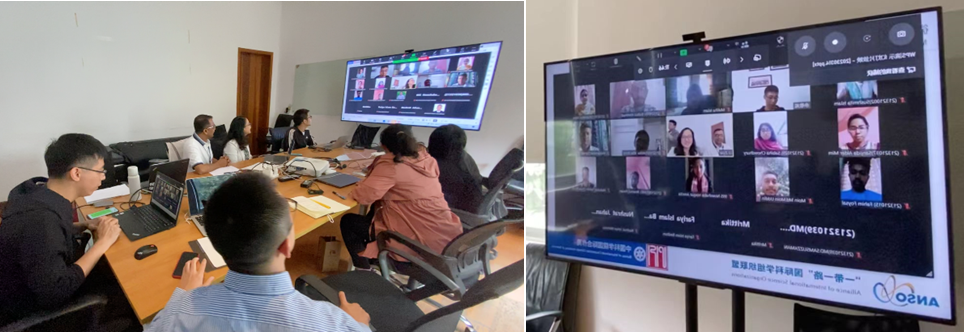Plastics including microplastics are now ubiquitous in our environment. According to data released by the United Nations, more than 400 million tons of plastics are produced globally each year, and tens of millions of tons of plastic waste flow into the oceans. Global initiative is required to solve the problem of plastic pollution. At the resumed fifth session of the United Nations Environment Assembly (UNEA-5.2) in 2022, UNEA Resolution 5/14 entitled “End plastic pollution: Towards an international legally binding instrument” was adopted to develop an international legally binding instrument on plastic pollution.
Under the support of the Alliance of International Science Organizations (ANSO), Li Lei, Professor of the Shenzhen Institute of Advanced Technology (SIAT) of the Chinese Academy of Sciences (CAS), undertook a joint research project entitled "The Impact of Microplastics on Brain Health and Reproductive Health and the Damage of Barrier Function". In collaboration with Jahangirnagar University and Bangladesh University of Engineering and Technology from Bangladesh, Kyushu University from Japan, Hong Kong Polytechnic University, and Guilin Medical College, the project aims to contributing to tackle global plastic pollution by deepening public awareness and providing laboratory basis for possible solutions through conducting collaborative research on the mechanism and effects of microplastic pollution on human health.
The project team has made encouraging progress in joint research and international cooperation over the past year and a half.
I. Joint Research and International Cooperation
The research team has yielded a series of results in the area of physiological hazards of microplastics and their attached organic pollutants, and published several articles in journals such as Journal of Hazardous Materials, Science of the Total Environment, Chemosphere, Toxics, Environment International, and Environmental Pollution. Related findings have been cited by the updated version of The World Health Organization report - Dietary and inhalation exposure to nano- and microplastic particles and potential implications for human health (WHO, 2022).
Figure 1: Early research foundation: Mouse model of microplastic inhalation exposure (Lu et al.,2021) cited by the WHO report (WHO, 2022)
Figure 2: The research team discovered the widespread presence of microplastics on beaches, in marine fish, and in human habitats (Ho et al., 2022; Lo et al., 2023),
and found that they not only adsorb organic pollutants such as bisphenol A and perfluorooctane sulfonate (PFOS), but also disease-causing bacteria from sewage (Lai et al., 2022).
The research team further found that microplastics can cross the pulmonary barrier or the enteric barrier to enter other visceral organs. Microplastics and/or endocrine-disrupting chemicals negatively affect reproductive function and embryonic development (Yang et al.,2023; Li et al.,2022; Tsukazawa et al.,2022).
Figure 3: Collaborating with Kyushu University and Guilin Medical College to study the effects of
microplastics/nanoplastics and organic pollutants on sperm production and embryonic development
From February to March 2023, the project team successfully organized the Microplastics and Brain - Reproductive Health International Academic Conference. More than 40 experts from 7 institutions attended the conference and conducted academic exchanges on the progress of the project and microplastics-related topics. The project team also organized the "CAS SIAT-Bangladesh Jahangirnagar University Microplastics-Brain and Reproduction Workshop", with the attendance of 20 Bangladeshi university students online. Prof. Billah, the project co-PI, expressed his gratitude to ANSO for its support, noting that in the context of the research funding crisis in developing countries, ANSO plays an important role in enhancing regional and global technological innovation, and promoting science and technology exchanges and cooperation.
Figure 4: The research team successfully hosted the “Microplastics and Brain - Reproductive Health International
Academic Conference” and"CAS SIAT-Bangladesh Jahangirnagar University Microplastics-Brain and Reproduction Workshop" during the first half of 2023.
II. International Dissemination and Impact
The importance of the project has also been recognized and supported by The IOC Sub-Commission for the Western Pacific of the United Nations Educational, Scientific and Cultural Organization (UNESCO-IOC/WESTPAC).
The project team has established in-depth international collaboration with the participating teams from Bangladesh and Japan, through carrying out the research context including the environmental characterization of microplastics, mammalian toxicological modeling, and brain and reproductive impact assessment. The team also attaches importance of research progress dissemination in order to deepen public awareness of microplastic pollution.
III. Future Plan
Under the ANSO international cooperation framework, there are plans to strive for the involvement of institutions from the Belt and Road countries, for example Thailand and Pakistan, in joining the collaborative project network. The goal is to facilitate the open sharing of research resources and technology. Additionally, there's a plea for the global community to give greater consideration to the problem of microplastic pollution, advance pertinent solutions, support the high-standard advancement of the Belt and Road Initiative, and actively pursue the attainment of the United Nations Sustainable Development Goals.
List of publications of the project team:
Lu K, Lai K P, Stoeger T, et al. Detrimental effects of microplastic exposure on normal and asthmatic pulmonary physiology[J]. Journal of Hazardous Materials, 2021, 416: 126069.
Ho Y W, Lim J Y, Yeoh Y K, et al. Preliminary Findings of the High Quantity of Microplastics in Faeces of Hong Kong Residents[J]. Toxics, 2022, 10(8): 414.
Lo, H. S., Wong, L. C., Lai, K. P., & Cheung, S. G. The influences of spatial-temporal variability and ecological drivers on microplastic in marine fish in Hong Kong[J]. Environmental pollution, 2023, 327, 121527.
Lai K P, Tsang C F, Li L, et al. Microplastics act as a carrier for wastewater-borne pathogenic bacteria in sewage[J]. Chemosphere, 2022, 301: 134692.
Yang S,Li M, Kong R, et al. Reproductive toxicity of micro- and nanoplastics, Environment International, 2023.108002.
Li Z, Lin Z, Ji S, et al. Perfluorooctanesulfonic acid exposure altered hypothalamic metabolism and disturbed male fecundity[J]. Science of The Total Environment, 2022, 844: 156881
Kazumi Sunny Tsukazawa#, Lei Li, William Ka Fai Tse*. 2,4-dichlorophenol exposure induces lipid accumulation and reactive oxygen species formation in zebrafish embryos. Ecotoxicology and Environmental Safety, 2022, 230:113133.
Publicity on ANSO platform:
Source: Li Lei, Professor, Shenzhen Institute of Advanced Technology, Chinese Academy of Sciences, saralilei@siat.ac.cn





